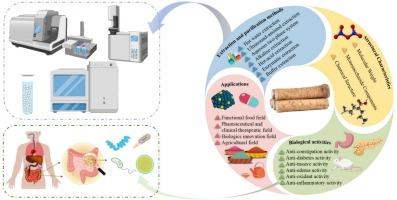Research progress on extraction and purification, structural characteristics, biological activities, structure-activity relationships, and applications of Arctium lappa L. (burdock) polysaccharides: A review
IF 8.5
1区 化学
Q1 BIOCHEMISTRY & MOLECULAR BIOLOGY
International Journal of Biological Macromolecules
Pub Date : 2025-08-27
DOI:10.1016/j.ijbiomac.2025.147187
引用次数: 0
Abstract
Arctium lappa L. (burdock) is a plant of the genus Arctium in the family Asteraceae, which is a commonly used food and medicinal resource. Notably, burdock polysaccharides are essential active components with remarkable and beneficial biological activities, including anti-constipation, anti-diabetes, anti-tussive, anti-edema, anti-oxidant, and anti-inflammatory. The biological activity mechanism of burdock polysaccharides is closely related to their structures. Currently, in addition to traditional extraction methods, novel methods are being developed for extracting burdock polysaccharides. Additionally, burdock polysaccharides have potential novel applications in biologics and agriculture. Therefore, this paper provides a systematic and in-depth review of the research progress on the extraction and purification of polysaccharides from burdock, their structural characteristics, biological activities, structure-activity relationships, and applications. It is hoped that this framework will provide a theoretical foundation for future studies, applications, and advancements in human health and product development.

牛蒡多糖的提取纯化、结构特性、生物活性、构效关系及应用研究进展
牛蒡是菊科牛蒡属植物,是一种常用的食品和药用资源。值得注意的是,牛蒡多糖是人体必需的活性成分,具有显著的抗便秘、抗糖尿病、止咳、抗水肿、抗氧化、抗炎等有益的生物活性。牛蒡多糖的生物活性机制与其结构密切相关。目前,除了传统的提取方法外,人们正在开发新的提取牛蒡多糖的方法。此外,牛蒡多糖在生物制剂和农业方面具有潜在的新应用前景。因此,本文就牛蒡多糖的提取纯化、结构特征、生物活性、构效关系及应用等方面的研究进展进行了系统、深入的综述。希望这一框架将为人类健康和产品开发的未来研究、应用和进步提供理论基础。
本文章由计算机程序翻译,如有差异,请以英文原文为准。
求助全文
约1分钟内获得全文
求助全文
来源期刊
CiteScore
13.70
自引率
9.80%
发文量
2728
审稿时长
64 days
期刊介绍:
The International Journal of Biological Macromolecules is a well-established international journal dedicated to research on the chemical and biological aspects of natural macromolecules. Focusing on proteins, macromolecular carbohydrates, glycoproteins, proteoglycans, lignins, biological poly-acids, and nucleic acids, the journal presents the latest findings in molecular structure, properties, biological activities, interactions, modifications, and functional properties. Papers must offer new and novel insights, encompassing related model systems, structural conformational studies, theoretical developments, and analytical techniques. Each paper is required to primarily focus on at least one named biological macromolecule, reflected in the title, abstract, and text.

 求助内容:
求助内容: 应助结果提醒方式:
应助结果提醒方式:


